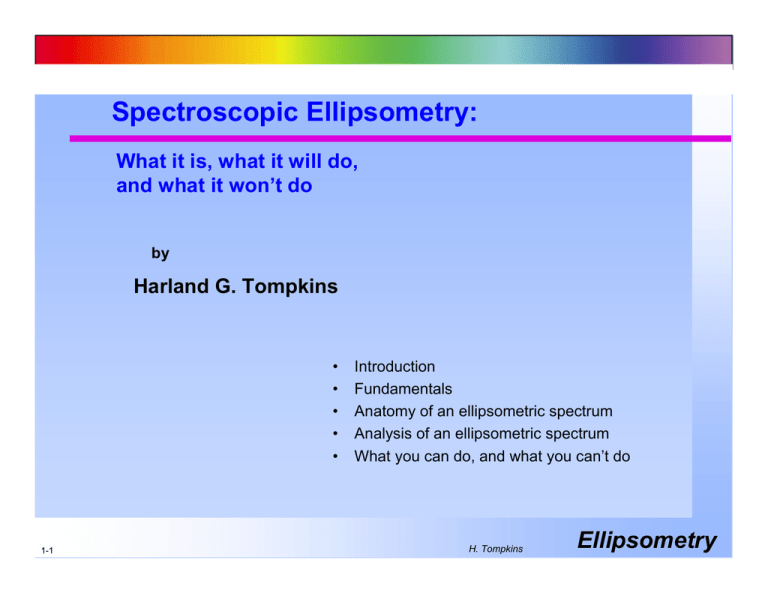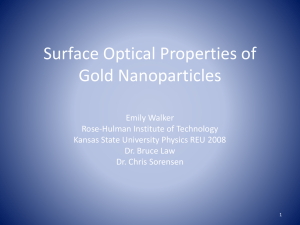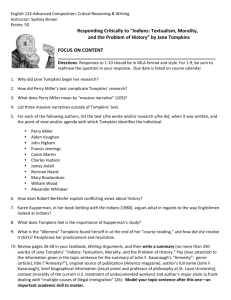Spectroscopic Ellipsometry: What It Is, What It Will Do, and What It
advertisement

Spectroscopic Ellipsometry: What it is, what it will do, and what it won’t do by Harland G. Tompkins • • • • • 1-1 Introduction Fundamentals Anatomy of an ellipsometric spectrum Analysis of an ellipsometric spectrum What you can do, and what you can’t do H. Tompkins Ellipsometry Introduction Perspective • Spectroscopic Ellipsometry is an optical technique used for analysis and metrology • A light beam is reflected off of the sample of interest • The light beam is then analyzed to see what the sample did to the light beam • We then draw conclusions about the sample • • thickness optical constants • microstructure • Model based • 1-2 all measurement techniques are model based H. Tompkins Ellipsometry Fundamentals Polarized Light • The Name • • “Ellipsometry” comes from “elliptically polarized light” better name would be “polarimetry” + • Linearly Polarized • 1-3 = combining two light beams in phase, gives linearly polarized light H. Tompkins Ellipsometry Fundamentals Polarized Light (continued) • Elliptically Polarized • combining two light beams out of phase, gives elliptically polarized light • Two ways • • + = pass through a retarder reflect off a surface • absorbing material • substrate with film 1-4 H. Tompkins Ellipsometry Fundamentals Laws of Reflection and Refraction • Reflection φi = φr • Refraction (Snell’s law) • for dielectric, i.e. k = 0 • in general n1 sin φ1 = n 2 sin φ 2 Ñ 1 sin φ 1 = Ñ 2 sin φ 2 • • sine function is complex corresponding complex cosine function sin 2 φ 2 + cos 2 φ 2 = 1 1-5 H. Tompkins Ellipsometry Fundamentals Reflections (orientation) • Electric Field Vector • Plane-of-Incidence • • • incoming normal outgoing Ep Es Plane of Incidence • s-waves and p-waves • 1-6 “senkrecht” and “parallel” H. Tompkins Ellipsometry Fundamentals Equations of Fresnel • Fresnel reflection coefficients, • complex numbers p 12 r r12s • ratio of Amplitude of outgoing to incoming • different for p-waves and s-waves Ñ 2 cos φ 1 − Ñ 1 cos φ 2 r = Ñ 2 cos φ 1 + Ñ 1 cos φ 2 p 12 • Reflectance • • • ℜ ratio of Intensity square of Amplitude for a single interface p 2 12 ℜ =r p 1-7 Ñ 1 cos φ 1 − Ñ 2 cos φ 2 r = Ñ 1 cos φ 1 + Ñ 2 cos φ 2 s 12 s 2 12 ℜ =r s H. Tompkins Ellipsometry Fundamentals Brewster Angle (for dielectrics) • • • • r s always negative and non-zero r p passes through zero ℜ p goes to zero The Brewster Angle • sometimes called the principal angle, polarizing angle • Reflected light is s-polarized • ramifications n • tan φ B = 2 n1 • 1-8 cos φ 2 = sin φB H. Tompkins Ellipsometry Fundamentals “Brewster” Angle, for metals • if k is non-zero, r s and r p are complex • cannot plot r s and r p vs angle of incidence • However, we can still plot the Reflectance • ℜ p has a minimum, although not zero • Actually called the “principal angle” 1-9 H. Tompkins Ellipsometry Fundamentals Reflections with Films φ1 • Ellipsometry, • Amplitude, phase of outgoing vs incoming • Reflectometry • • p p r12 + r23 exp(− j2β ) R = p p 1 + r12 r23 exp(− j2β ) β is phase change from top to bottom of film 1-10 φ2 d Ñ3 φ3 corresponds to Fresnel Coefficients complex number p • Ñ2 Intensity of outgoing vs incoming • Total Reflection Coefficient • Ñ1 s s + r r s 12 23 exp(− j2β ) R = s s 1+ r12 r23 exp(− j2β ) d β = 2 π Ñ2 cos φ 2 λ H. Tompkins Ellipsometry Fundamentals Ellipsometry and Reflectometry definitions • Reflectance ℜ = R p p2 s 2 ℜ = R s • Delta, the phase difference induced by the reflection • if δ1 is the phase difference before, and δ2 the phase difference after the reflection then • ∆ = δ1 - δ 2 ranges from zero to 360º (or -180 to +180º ) • Psi, the ratio of the amplitude diminutions • tan Ψ = ranges from zero to 90º Rp Rs • The Fundamental Equation of Ellipsometry Rp ρ= s R 1-11 ρ = tan Ψ e j∆ tan Ψ e H. Tompkins j∆ Rp = s R Ellipsometry Fundamentals More Perspective • Ellipsometers measure ∆ and Ψ (sometimes only cos ∆ ) • Properties of the probing beam • Quantities such as thickness and index of refraction are calculated quantities, based on a model. • Properties of the sample • Values of ∆ and Ψ are always correct • Whether thickness and index are correct depend on the model • Both precision and accuracy for ∆ and Ψ • Precision for thickness • Accuracy, ??? 1-12 H. Tompkins Ellipsometry The Anatomy of an Ellipsometric Spectrum Examples 180 • Thin oxides on Silicon 150 ∆(°) 120 50 90 60 film-free 10 Å 25 Å 30 60 Å 100 Å 40 Ψ(°) film-free 10 Å 25 Å 60 Å 100 Å 30 0 200 400 20 600 800 1000 Wavelength (nm) 10 0 200 400 600 800 1000 Wavelength (nm) Si Optical Constants 6.0 n k 5.0 5.0 4.0 3.0 3.0 2.0 2.0 1.0 1.0 200 400 600 Wavelength (nm) 800 0.0 1000 SiO2 Optical Constants 1.58 0.10 1.56 n k 0.08 1.54 0.06 1.52 0.04 1.50 0.02 1.48 1.46 200 400 600 800 Ext. Coeff. ' k' 4.0 Ext. Coeff. ' k' Index 'n' 6.0 Index 'n' 7.0 0.00 1000 Wavelength (nm) 1-13 H. Tompkins Ellipsometry The Anatomy of an Ellipsometric Spectrum Examples • Thicker oxide on Silicon 360 2200 Å 2500 Å 60 ∆ in degrees Ψ in degrees 90 30 240 2200 Å 2500 Å 120 180 150 0 200 400 600 800 0 200 1000 400 800 120 2200 Å 2500 Å 1000 Wavelength (nm) ∆ Wavelength (nm) 600 90 60 30 200 Si Optical Constants Index 'n' 4.0 4.0 3.0 3.0 2.0 2.0 1.0 400 600 Wavelength (nm) 800 1000 0.0 1000 SiO2 Optical Constants 1.58 0.10 1.56 n k 0.08 1.54 0.06 1.52 0.04 1.50 0.02 1.48 1.46 200 400 600 800 Ext. Coeff. ' k' 5.0 1.0 200 800 5.0 Ext. Coeff. ' k' n k 600 Wavelength (nm) 6.0 6.0 Index 'n' 7.0 400 0.00 1000 Wavelength (nm) 1-14 H. Tompkins Ellipsometry The Anatomy of an Ellipsometric Spectrum Examples • Polysilicon on oxide on silicon 3 2 1 0 srough polysilicon sio2 si 25 Å 3000 Å 1000 Å 1 mm 180 90 ∆ Ψ in degrees 120 60 60 30 0 200 0 200 400 600 800 400 600 800 1000 Wavelength (nm) 1000 Wavelength (nm) 5.0 5.0 4.0 4.0 3.0 3.0 2.0 n k 2.0 1.0 200 400 600 800 1.0 Ext. Coeff. ' k' Index 'n' polysilicon OC's 6.0 0.0 1000 Wavelength (nm) 1-15 H. Tompkins Ellipsometry The Anatomy of an Ellipsometric Spectrum Examples 1 cr 0 si • Thin chromium on silicon 300 Å 1 mm 180 60 Ψ 40 ∆ in degrees film-free 50 Å 100 Å 200 Å 300 Å 20 0 300 400 500 600 700 120 film-free 50 Å 100 Å 200 Å 300 Å 60 0 300 800 400 500 600 700 800 Wavelength (nm) Wavelength (nm) Chromium OC's 5.0 4.5 4.2 Index 'n' • caveats 3.9 3.0 n k 3.6 3.3 2.0 3.0 1.0 0.0 300 Ext. Coeff. ' k' 4.0 2.7 400 500 600 700 2.4 800 Wavelength (nm) 1-16 H. Tompkins Ellipsometry Analysis of an Ellipsometric Spectrum Determining Film properties from SE spectra • Except for substrates, we cannot do a direct calculation What Ellipsometry Measures: What we are interested in: Psi (Ψ) Delta (∆) Desired information must be extracted Through a model-based analysis using equations to describe interaction of light and materials 1-17 Film Thickness Refractive Index Surface Roughness Interfacial Regions Composition Crystallinity Anisotropy Uniformity H. Tompkins Ellipsometry Analysis of an Ellipsometric Spectrum How we analyze data: 1-18 H. Tompkins Ellipsometry Analysis of an Ellipsometric Spectrum Building the model • Optical Constants • Tabulated list • when OC’s are very well known 1 cauchy 0 si • single-crystal 0Å 1 mm • thermal oxide of Si, LPCVD nitride • Dispersion Equation • Cauchy equation • dielectrics, primarily • empirical • not K-K consistent n(λ ) = An + 1-19 Bn 2 + λ Cn λ4 H. Tompkins Ellipsometry Analysis of an Ellipsometric Spectrum Building the model • Optical Constants • 2 polysilicon 1 sio2 0 si Dispersion Equation • Oscillator equation 6.0 5.0 Ext. Coeff. ' k' Index 'n' 5.0 4.0 3.0 2.0 1.0 0.0 0 300 600 900 1200 1500 4.0 3.0 2.0 1.0 0.0 0 1800 300 600 Wavelength (nm) 900 1200 1500 1800 Wavelength (nm) 5.0 4.0 30 4.0 20 3.0 15 25 2.0 0.0 0 300 5 600 900 1200 1500 1800 ε2 1.0 10 'k' 'n' 3.0 ε1 0Å 1000 Å 1 mm 2.0 20 1.0 15 0.0 0 300 600 Wavelength (nm) 900 1200 1500 1800 Wavelength (nm) 10 0 5 -5 -10 0 0 0 2 4 6 Photon Energy (eV) 1-20 8 10 2 4 6 8 10 Photon Energy (eV) H. Tompkins Ellipsometry Analysis of an Ellipsometric Spectrum Building the model • Optical Constants • Mixture • EMA, effective medium approximation 1-21 • Graded Layers • Anisotropic Layers • Superlattice 3 2 1 0 srough polysilicon sio2 si H. Tompkins 0Å 2000 Å 1000 Å 1 mm Ellipsometry Analysis of an Ellipsometric Spectrum Building the model • Seed Values • Thickness • process engineer’s guess • analyst's guess • trial-and-error • • till it looks good Cauchy coefficients • An between ~ 1.4 and 2.2 • higher for poly or a_Si • Oscillators • tough • “GenOsc” formalism A wise old sage once said: “The best way to solve a problem is to have solved one just like it yesterday.” 1-22 H. Tompkins Ellipsometry Analysis of an Ellipsometric Spectrum The regression process • Don’t turn all the variables loose to begin with • e.g. for a Cauchy • thickness first • then An and thickness • then include Bn • add in extinction coefficient • For a stack • don’t try to determine thicknesses and OC’s simultaneously • creative deposition • “done” is a relative term • 1-23 does it make sense A wise old sage once said: “You can have it all, you just can’t have it all at once.” H. Tompkins Ellipsometry What you can do, and what you can’t do Requirements • plane parallel interfaces • roughness • film must be uniform • • graded layers anisotropic layers • multilayers • need to know something about OC’s • coherence • • • patterned wafers non-uniform thickness macroscopic roughness • helps if the film-of-interest is on top • optical contrast • 1-24 polymer on glass H. Tompkins Ellipsometry What you can do, and what you can’t do Optical Constants of Very Thin Films • consider a single wavelength (632.8 nm) at 70° • oxynitride on silicon • Delta/Psi trajectories • below 100Å, very difficult to determine index, n • • distinguishing one material from another determining thicknesses in a stack • e.g., ONO • however, if you’re willing to assume n, can determine thickness of very thin film • • 1-25 classic experiment of Archer how far can you be off? H. Tompkins Ellipsometry What you can do, and what you can’t do Optical Constants of Very Thin Films making it better • DUV or VUV • • directions shorter wavelengths extinction coefficient often nonzero • IR • 1-26 absorption bands are different for different materials H. Tompkins Ellipsometry What you can do, and what you can’t do Optical Constants of Very Thin Films φ1 Ñ1 Ñ2 Fundamental Limitation • Our ability to make films with: • • 1-27 φ2 Ñ3 d φ3 plane parallel interfaces uniformity H. Tompkins Ellipsometry Acknowledgements • Bell Laboratories, prior to the divestiture (< 1982) • Motorola • J. A. Woollam Co., Inc. • James Hilfiker • Stefan Zollner 1-28 H. Tompkins Ellipsometry


